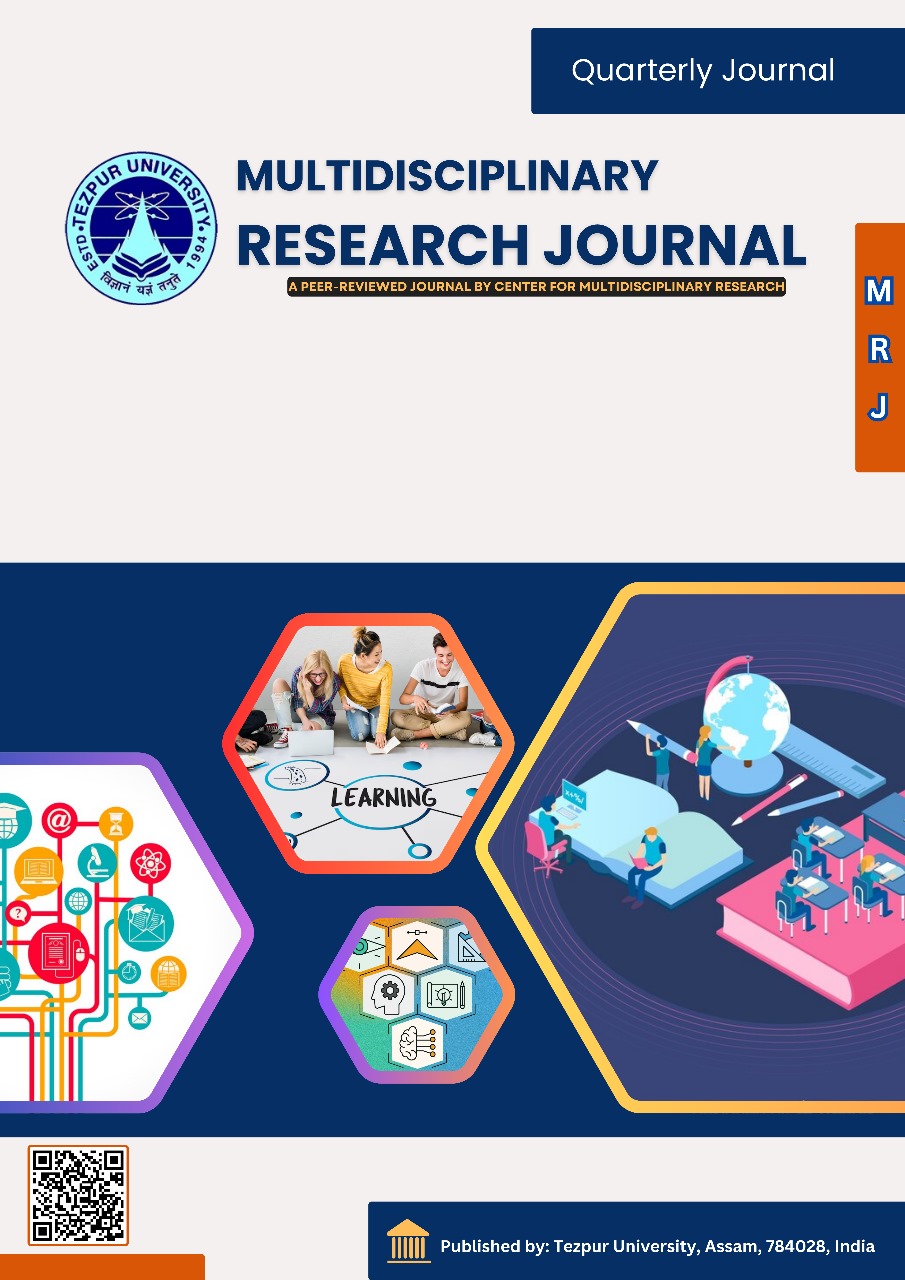Sial and the Zo: Understanding Human-Mithun Relations in Sialkal Range, Mizoram
DOI:
https://doi.org/10.63635/mrj.v1i1.12Keywords:
Zo people, mithun (sial), human-animal relation, socio-cultural identity, rituals and traditions, language and ecology, oral narratives, Sialkal Range, Mizoram, Northeast IndiaAbstract
This study explores the multifaceted relations between the Zo people and the mithun (Bos frontalis), locally known as ‘sial,’ a culturally significant animal in Northeast India. Focusing on the Sialkal Range in Mizoram, the research employs participant observation, in-depth interviews, and secondary literature analysis to examine the deep integration of the sial in the Zo people’s socio-cultural life. Traditionally, the sial is considered a powerful symbol of social status, wealth, and cultural pride, playing a central role in rituals, marriage negotiations, ceremonial rites, and oral traditions. Its presence permeates daily practices and language, with place names like the Sialkal Range and oral narratives reflecting its cultural significance. The study also highlights the linguistic aspects of human-animal relation, including vocal calls and material interactions like salt offerings that strengthen bonds with the sial. Through its analysis of symbolism, customs, and ecological entanglements, the research underscores the sial’s role in shaping Zo identity and their perception of the natural world.
Downloads
References
[1] Morris, B. Anthropology, Ecology, and Anarchism: A Brian Morris Reader; PM Press: Oakland, CA, USA, 2014.
[2] Aiyadurai, A. ‘Tigers Are Our Brothers’: Understanding Human-Nature Relations in the Mishmi Hills, Northeast India. Conserv. Soc. 2016, 14, 305–316.
[3] Pachuau, J.L.K.; van Schendel, W. Entangled Lives; Cambridge University Press: Cambridge, UK, 2022, https://doi.org/10.1017/9781009215480.
[4] Govindrajan, R. Animal Intimacies: Interspecies Relatedness in India’s Central Himalayas; University of Chicago Press: Chicago, IL, USA, 2018.
[5] Kirksey, S.E.; Helmreich, S. The Emergence of Multispecies Ethnography. Cult. Anthropol. 2010, 25, 545–576, https://doi.org/10.1111/J.1548-1360.2010.01069.X.
[6] Sarma, A.; Zoliana, J. Changing Affinities: Ecologies of Human-Mithun Relationships in Northeast India; North Eastern Social Research Centre: Guwahati, India, 2023.
[7] Aiyadurai, A. Tigers Are Our Brothers: Anthropology of Wildlife Conservation in Northeast India; Oxford University Press: Oxford, UK, 2021.
[8] Simoons, F.J.; Simoons, E.S. A Ceremonial Ox of India; The Mithan in Nature, Culture, and History, with Notes on the Domestication of Common Cattle; University of Wisconsin Press: Madison, WI, USA, 1968.
[9] Thangtungnung, H. Ethnic History and Identity of the Zo Tribes in Northeast India. J. North East India Stud. 2015, 5, 39–50. Available online: http://www.jneis.com (accessed on 02 December 2024).
[10] Siamkhum, T. The Paites: A Study of the Changing Faces of the Community; Notion Press: Chennai, India, 2013.
[11] Khiangte, L.; Patnaik, J.K. The Paite Movement for Autonomy in Mizoram. Contemp. Soc. Sci. 2018, X, 13–17.
[12] Government of Mizoram. Available online: https://gad.mizoram.gov.in/page/brief-history-of-sialkal-range-development-council (accessed on 02 December 2024).
[13] Basso, K.H. Wisdom Sits in Places: Landscape and Language among the Western Apache; University of New Mexico Press: Albuquerque, NM, USA, 1996.
[14] Lalremruati, R. Oral Literature: A Study of Mizo Folk Songs. Doctor of Philosophy, Mizoram University, Aizawl, India, 2012.
[15] Aiyadurai, A.; Varma, S. Dog and Bull: An Investigation into Carnivore-Human Conflict in and around Itanagar Wildlife Sanctuary, Arunachal Pradesh; Wildlife Trust of India: New Delhi, India, 2008; Occasional Report No. 9.
[16] Lévi-Strauss, C. The Elementary Structures of Kinship, Revised ed.; Bell, J.H., von Sturmer, J.R., Needham, R., Eds.; Beacon Press: Boston, MA, USA, 1977.
[17] The Mizoram Gazette. The Mizo Customary Law. 2005. Available online: https://printingstationery.mizoram.gov.in/storage/site/files/gazette_1244_534ea86b5c5c3.pdf (accessed on 03 December 2024).
[18] Guite, M.V. Writings from the ‘Periphery’: Folktales and Other Forms of Literature of the Paite Tribe of Manipur. In Literatures from Northeast India: Beyond the Centre-Periphery Debate; Islam, B.K.M., Ed.; Routledge: London, UK, 2022; pp. 32–50.
[19] Paite Literature Society. Paite Pau Sinna (Paite Reader IX and X); Paite Laipau Sinpawl: Lamka, India, 2012.
[20] Kamkhenthang, H. Folk Songs of the Paite; Tribals and Backward Classes: Manipur, India, 1989.
[21] Ong, W.J. Orality and Literacy: The Technologizing of the Word; Routledge: London, UK, 1982.
[22] Hymes, D.H. Foundations in Sociolinguistics: An Ethnographic Approach; Routledge: London, UK, 2001.
[23] Levi-Strauss, C. The Savage Mind; George Weidenfeld and Nicolson Ltd: London, UK, 1966.
[24] Ingold, T. The Perception of the Environment; Routledge: London, UK, 2002, https://doi.org/10.4324/9780203466025.
Downloads
 Abstract Display: 429
Abstract Display: 429  PDF Downloads: 229
PDF Downloads: 229 Published
Issue
Section
License

This work is licensed under a Creative Commons Attribution-NonCommercial 4.0 International License.
Copyright © Author(s) retain the copyright of this article.




